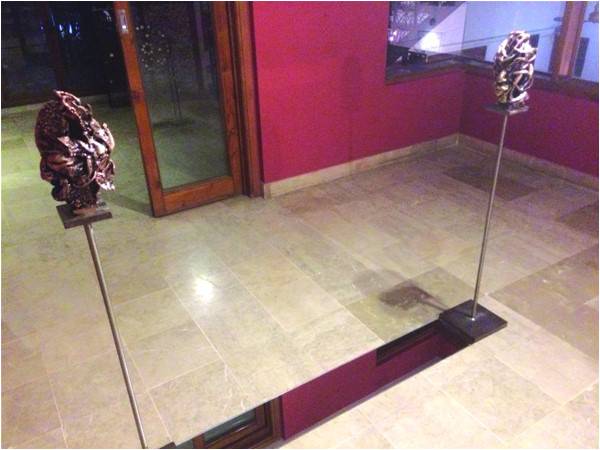
The closest thing Pakistan’s art world has to a rock star, Amin Gulgee, opened a new show at his not-for-profit gallery. Titled ‘7’, the show’s biggest work is reminiscent of Washed Upon the Shore, Amin’s solo at Canvas in 2015; where Erum Bashir rolled in a coal-filled room, white clothes blackening, eerie, industrial moon looming over her. Fast forward to today, and you approach this piece like entering a temple. He might as well have asked us to be barefoot! An immense carpet of coal fills the room, where calligraphic letters lie scattered like shells. Alphabets from a sacred text are treasures lying in the coal. On all four sides, his copper curtains and tall screens stand like scrolls – their letters forming beautiful spidery shadows on the walls. And if you speak to Amin, there is much talk about rituals, and African masks; and some of his pieces are totem-like. There is a sacredness to it all.
The screens are undulating lovely curves, nuqtas and dips of Arabic. Some, like his Salt screen, are gentler and translucent. The others are powerful walls of copper with the letters cut out. Specifically, they form his fascination with the Quranic Surah Alaq (The Clot). Over the years it has weaved through his work. He has focused on and unpacked its letters.
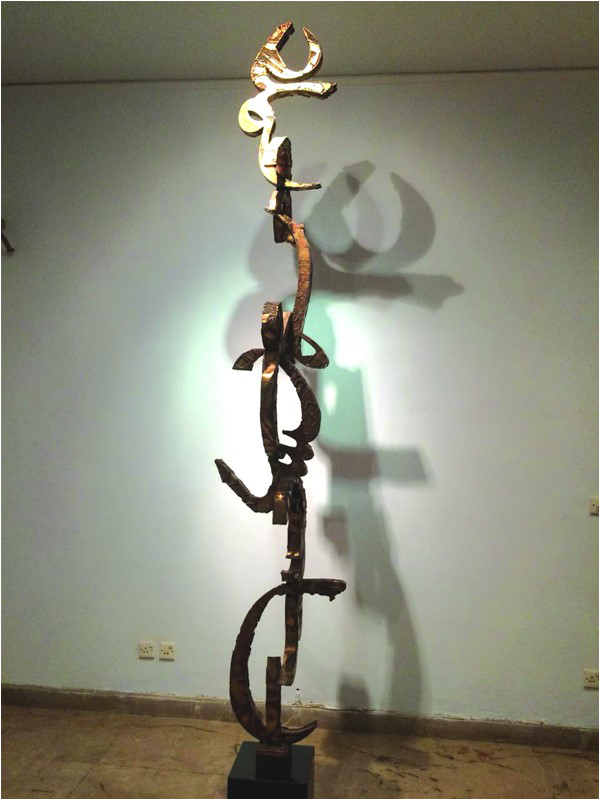
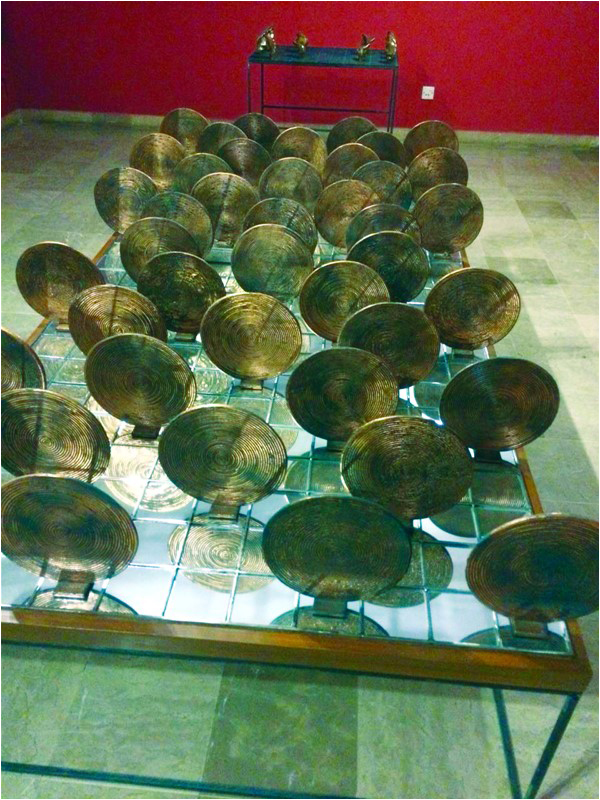
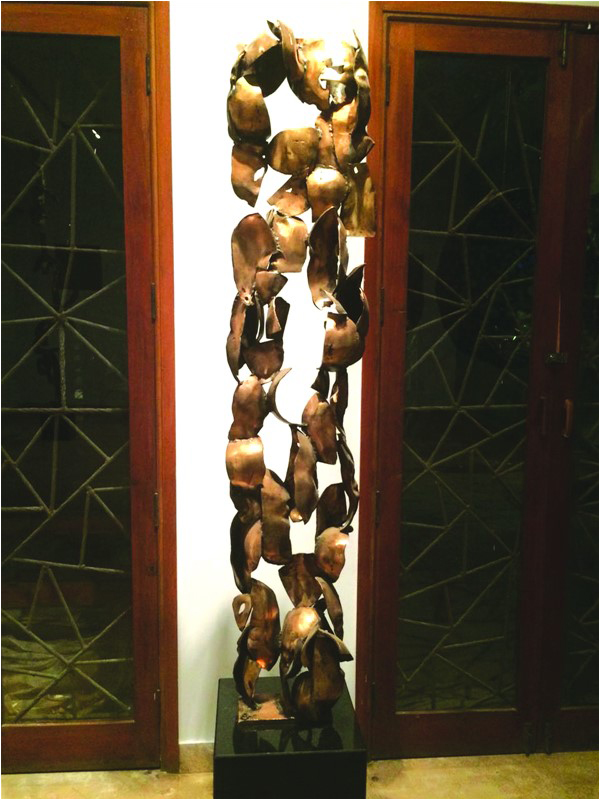
Always theatrical, this installation, however, is dark and has a sombreness to it. It isn’t mirrors and gold like his 2014 performance ‘’Where’s the apple Joshinder?’’—where Joshinder Chaggar and 4 other characters explore themselves and a shimmering “Char Bagh” of 77 floating leaves, and then burn it to the ground, filling the stage with smoke and the clang of bronze. This piece, contrastingly feels like a carcass. A rusting ship, or a dead queen’s chamber. It is evocative and moving. In the gallery’s courtyard, an exuberant structure reminiscent of church windows, glows with coloured glass.
If you are a regular at these things, you know each art gallery has its own audience, and the Amin Gulgee gallery is no different. Over the years Amin has assembled a goulash— young artists enamoured by his light; senior art fraternity he considers peers; writers and personalities he has often clashed with; fashion models and musicians; socialites and sound artists. When they all enter the show they are accosted by a performance work you can participate in. Rows of amber glass bottles and note paper line tables, and you are invited to fill a bottle with a secret note, and leave it anywhere in the gallery. Confidentiality is promised: the bottles will be destroyed after the show.
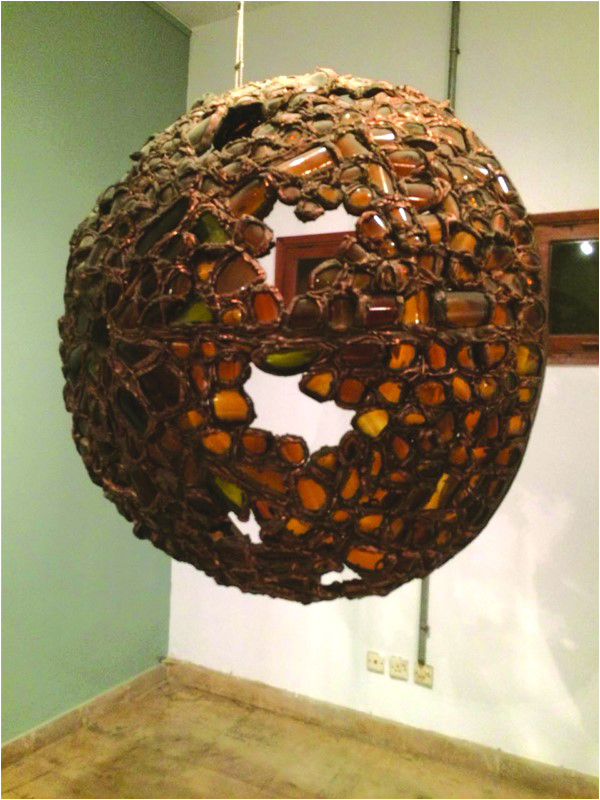
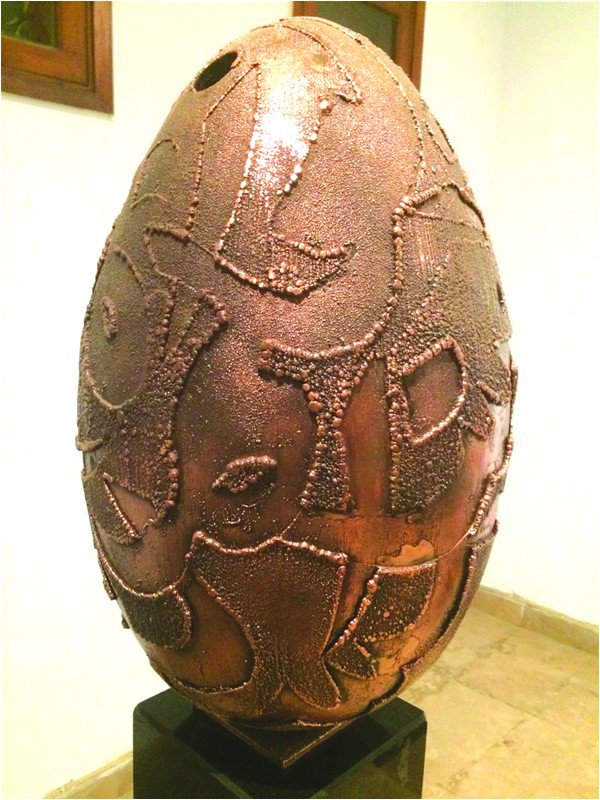
This caused nervous giggles, befuddlement and concentration. One visitor announced that she wrote to God. Interestingly, someone wrote to a dead relative “because maybe a letter that’s going nowhere, “they said, “can reach a place you can’t reach.” Amin has always been interested in those very places – the ones that need creating. These are spaces where performative art can be shown and understood and written about. At the recent Karachi Biennale, where he was the chief curator, the Urdu press struggled with finding the language to talk about the work, or even the understanding of the art itself. Amin welcomes the young and experimental that a commercial gallery would shun, proudly displaying their collections of maggots eating meat (the show ‘Fresh!’ in 2014). Back when our fashion industry was in its infancy, Amin pushed and cajoled to create an unheard-of space between, fashion, theatre and art. His curatorial themes have explored human relations and the boundaries of what society agrees on.
There’s a continuous thread weaving through his shows, and perhaps you wish it weren’t so easy to follow. His egg forms are here, last seen in 2015, beginning with his fascination with the idea of birth, the Char Bagh and chapati-like structures from 2013.
7 is more retrospective than new material, but stunning nonetheless. At the end of the day, no one can be Amin, and no one can do what Amin does.
The screens are undulating lovely curves, nuqtas and dips of Arabic. Some, like his Salt screen, are gentler and translucent. The others are powerful walls of copper with the letters cut out. Specifically, they form his fascination with the Quranic Surah Alaq (The Clot). Over the years it has weaved through his work. He has focused on and unpacked its letters.



?Amin has always been interested in those very places – the ones that need creating. These are spaces where performative art can be shown, understood and written about
Always theatrical, this installation, however, is dark and has a sombreness to it. It isn’t mirrors and gold like his 2014 performance ‘’Where’s the apple Joshinder?’’—where Joshinder Chaggar and 4 other characters explore themselves and a shimmering “Char Bagh” of 77 floating leaves, and then burn it to the ground, filling the stage with smoke and the clang of bronze. This piece, contrastingly feels like a carcass. A rusting ship, or a dead queen’s chamber. It is evocative and moving. In the gallery’s courtyard, an exuberant structure reminiscent of church windows, glows with coloured glass.
If you are a regular at these things, you know each art gallery has its own audience, and the Amin Gulgee gallery is no different. Over the years Amin has assembled a goulash— young artists enamoured by his light; senior art fraternity he considers peers; writers and personalities he has often clashed with; fashion models and musicians; socialites and sound artists. When they all enter the show they are accosted by a performance work you can participate in. Rows of amber glass bottles and note paper line tables, and you are invited to fill a bottle with a secret note, and leave it anywhere in the gallery. Confidentiality is promised: the bottles will be destroyed after the show.


This caused nervous giggles, befuddlement and concentration. One visitor announced that she wrote to God. Interestingly, someone wrote to a dead relative “because maybe a letter that’s going nowhere, “they said, “can reach a place you can’t reach.” Amin has always been interested in those very places – the ones that need creating. These are spaces where performative art can be shown and understood and written about. At the recent Karachi Biennale, where he was the chief curator, the Urdu press struggled with finding the language to talk about the work, or even the understanding of the art itself. Amin welcomes the young and experimental that a commercial gallery would shun, proudly displaying their collections of maggots eating meat (the show ‘Fresh!’ in 2014). Back when our fashion industry was in its infancy, Amin pushed and cajoled to create an unheard-of space between, fashion, theatre and art. His curatorial themes have explored human relations and the boundaries of what society agrees on.
There’s a continuous thread weaving through his shows, and perhaps you wish it weren’t so easy to follow. His egg forms are here, last seen in 2015, beginning with his fascination with the idea of birth, the Char Bagh and chapati-like structures from 2013.
7 is more retrospective than new material, but stunning nonetheless. At the end of the day, no one can be Amin, and no one can do what Amin does.

